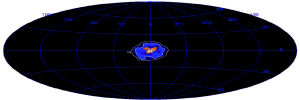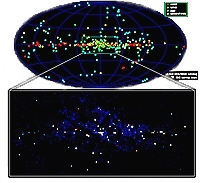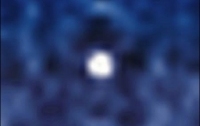Five Years of INTEGRAL
17 October 2007
The launch of INTEGRAL five years ago, on 17 October 2002, heralded a new era in gamma-ray observatories. Utilising solid-state detectors and coded mask imaging techniques, INTEGRAL was unlike any previous gamma-ray mission.In addition, the 72-hour elliptical orbit has allowed for deeper observations than previous missions have achieved. The outcome of this is a series of science results that have aided our understanding of some of the most fundamental processes at work in the Universe. These examples are a selection of INTEGRAL's numerous results.
Science Highlights
Nucleosynthesis and Gamma-Ray Lines
- The 511 keV annihilation sky map
INTEGRAL has provided the first Galactic map ever of the intensity and sky distribution of the characteristic 511 keV emission from electron-positron annihilation.
The emission was found to be very smooth and almost symmetrical around the Galactic centre with only a weak component along the galactic disk. The brightness of the emission and its central distribution (with approximately 1.5 × 1043 positrons annihilating every second in the Galactic bulge region) are as yet unexplained, as the likely stellar sources for positrons are not over-represented in the bulge region.
511 keV annihilation sky map
- Line emission from 26Al , 44Ti and 60Fe
Among the key scientific goals of INTEGRAL is the measurement of the line emission from radio-active isotopes of heavier elements in our Galaxy. With SPI's spectral resolution, INTEGRAL has been able to show the emission from 26Al at 1809 keV is Galaxy-wide by detecting the signature of Doppler shifted emission caused by the Galaxy's rotation. Line emission from the decay of 44Ti has only been observed from the young Cassiopeia A supernova remnant. INTEGRAL provided clear separate detections of two closely spaced lines, as well as an improved measurement of the supernova's underlying continuum emission up to 100 keV. The SPI instrument also successfully measured two gamma-ray lines resulting from the decay of 60Fe throughout our Galaxy. Combining the data from both lines resulted in the most-significant detection of this isotope to date.
Compact Sources
- The IBIS source catalogue
At the start of 2007, INTEGRAL had observed over 70% of the sky, with a total exposure time of 40 million seconds. Three years' worth of data has resulted in the third INTEGRAL catalogue of gamma-ray sources, containing a total of 421 gamma-ray objects. Most have been identified as either binary stars in our Galaxy containing black holes and neutron stars, or as active galaxies; with a quarter of the sources remaining unidentified so far.
Distribution of point sources in the third IBIS survey catalogue
- Resolution of diffuse continuum emission from Galactic centre
The Imager on-Board INTEGRAL Satellite (IBIS) already in the first year of science operations helped resolve a long-standing mystery. Its imaging resolution allowed it to resolve the diffuse gamma-ray continuum emission from the Galactic centre. The data showed that nearly all the emission could be accounted for by about 90 point sources. - Obscured High Mass X-ray Binaries (HMXBs)
Another discovery by INTEGRAL in its first year was that of a new class of HMXBs: obscured HMXBs. Follow-up observations with XMM-Newton of the first such object discovered, confirmed the existence of an obscured compact object (e.g. a black hole or neutron star) in the binary system. In HMXBs a cocoon of surrounding material blocks all but the most energetic photons (energies above 10 keV) emitted by the accretion disc around the compact object. - Hard spectra in Anomalous X-ray Pulsars (AXPs)
Originally thought to be X-ray binary systems, the detection of surprisingly powerful hard X-rays and gamma-rays (above 10 keV) from these objects by INTEGRAL provided clues to their true nature: pulsars with an extremely powerful magnetic field, or magnetars. - Giant black holes
With around 100 of the brightest supermassive black holes in other galaxies already detected by INTEGRAL, tens of millions of more distant black holes are thought to contribute to the diffuse gamma-ray background by emission from their accretion discs. Observations made with INTEGRAL in early 2006 have provided highly accurate data on this cosmic gamma-ray background. Models of the distribution of massive black holes in the nearby Universe can now be matched with the observed data.
Gamma-Ray Bursts
 |
|
First ever image of a gamma-ray burst, with IBIS on 25 November 2002 |
- Nearby GRB 031203
GRB 031203 was first detected by INTEGRAL on 3 December 2003 and provided approximate coordinates of the event to the community in a record time of 18 seconds. Subsequent studies in the following months showed that GRB 031203 was intrinsically a weak GRB that went off in a galaxy less than 1300 million light years away, making it one of the closest GRBs ever observed. This meant that a class of weak GRBs may exist, closer but also dimmer than the majority of GRBs known so far. - Giant outburst from SGR 1806-20
On 27 December 2004, a giant outburst was observed from the soft gamma-ray repeater SGR 1806-20 by many Earth and space based observatories. Models of SGRs have at their heart a rotating neutron star with an extremely powerful magnetic filed: a magnetar. SGR 1806-20's outburst is thought to have been caused by a large-scale rearrangement to a state of lower energy of the magnetar's super-strong magnetic field. The INTEGRAL observations of the event with the SPI anti-coincidence system (SPI-ACS) revealed the strong and short (0.7 second) outburst and a pulsating afterglow lasting ~5 minutes. - Localising bursts outside the field of view
SPI-ACS makes it possible for INTEGRAL to detect gamma-ray bursts when they occur outside the telescope's field of view, but it can not pinpoint their position. Results published in June 2006 showed that for some of these events INTEGRAL can also obtain a localisation of the GRB using the IBIS instrument in Compton mode. The finding has extended the telescope's ability to image energetic gamma-ray bursts.
Legacy
Since launch over 750 papers/articles have been published, including over 250 refereed publications. Based on INTEGRAL data, they cover many more results in addition to those highlighted here.
The INTEGRAL Science Data Centre (ISDC), located in Geneva, has placed online data from nearly 500 orbits - roughly the first four years of observation. The INTEGRAL science archives are accessible from both the ISDC and the INTEGRAL Science Operations Centre (ISOC) websites - see related links on the right-hand side. INTEGRAL's legacy so far includes source catalogues, as well as surveys of the Galactic plane and the Galactic centre. With both the spacecraft and payload in good condition, the mission continues to extend its legacy.
